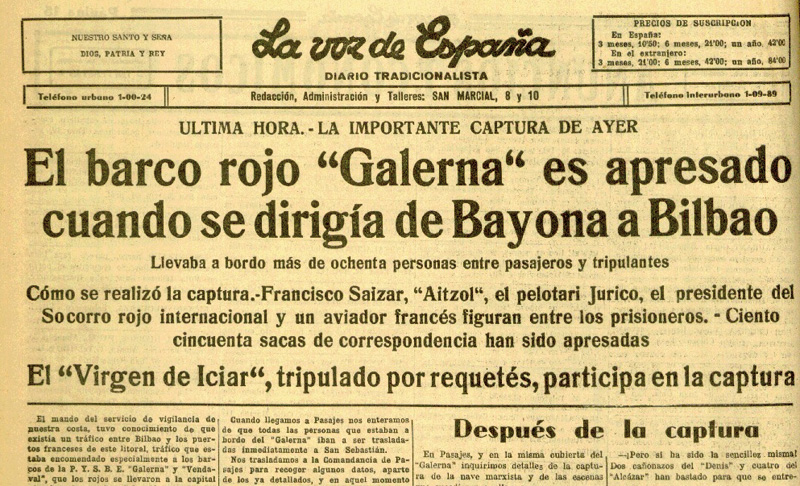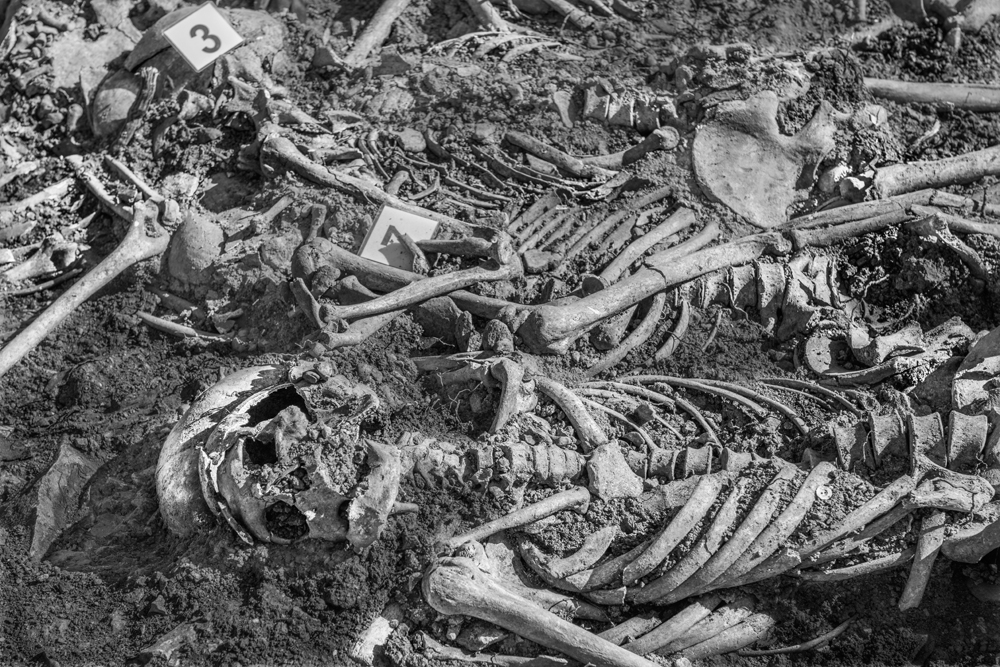The reported misfortune of a ploy
- On October 15, 1936, four bous Francoists seized the Galerna, a boat of cod headed from Baiona to Bilbao, and docked in Pasaia. The fascist press mocked the crew and the prisoners' travellers while praising the feat of the Requetés. Today we know that the Republican ship fell under the traps of a betrayal and that the headlines of the newspapers announced their misfortune.

In January 1937, Iraqi Republican Joxe Mari Lopetegi unleashed the pain inside Red Euzkadi:
Agur Manolo Gurutzeaga,
my fiña friend, besides gañekua singers,
noble and friendly; my mingana does not have a shadow to measure the work, those who have killed you everywhere have the soup of the devils, do not know what the
doctrine of Christ Zana is like.
Manuel Gurutzeaga Arruabarrena, 37, was shot on the wall of the Hernani cemetery when he was captured at the Galerna by Francoists along with several passengers. Astigartarra, by birth, had sung several times with Lopetegi, and Lopetegi had reminded him a lot in that series called Zorigaitzez.
On 22 October they organized a recital in Irun with the bertsos of Lopetegi, and it would be worthwhile to accommodate this type of bertsos: “... I mean in words measures / to sing Euskaldunes...”, says the Iraqi.
The history of the Galerna boat is known, especially by the people who have been captured on the spot. Among the travelers was the untiring Basque priest Jose Aristimuño Aitzol, who, after being tortured, ended in a mass grave with Gurutzeaga and many others in that dark fall of 36.
From the fleet of the Pasaia Pysbe Fishing Company, the Republicans used Galerna as many other vessels for war: First for the evacuation of Donostia-San Sebastián and then for the mail work. However, on October 15, 1936, when he was near Pasaia, he fell into the hands of the bous francoists in a very rare situation: “As soon as they launched three guns, Galerna gave up,” said the Spanish consul in Baiona in a report.
As soon as he got moored at the Antxo Pier, the public lynching of the 50 passengers began. The Diario Vasco, without smiling, will call Aitzol energy or ass, according to La Voz de España, which has been “a fat fish”. The “fat” Donostia physician Francisco Saizar, the well-known Pelotari “tongo” José Jurico, the “separatist” Juan Antonio Landi… They will all end up in a miserable state in Ondarreta prison in San Sebastian and three days later, on October 18, many of them will be shot. But we don't know what the fate of many others was.
The 28 crew members of the Galerna will not get rid of the poisonous words of El Diario Vasco: "They don't know anything, they're in Babia. If something happens to these children, which God does not want, they have a place in Limbo.” This is a place called San Cristobal, a fearsome prison on Mount Ezkaba, where two of the children will be hunted as animals in the famous escape of 1938.
The memory of those murders, the death of Aitzol, became one of the symbols of the cruelty of the Franco rearguard. As Lopetegi himself explained, inexcusable brutality – in Dierriya / boat ‘Galerna’ Ordaña...–. When in 1956 the umpteenth medal was awarded to Vice-Admiral Javier Mendizabal, the Franco authorities highlighted their participation in the capture of Galerna twenty years earlier. The press office of the Basque Government in exile immediately replied: “They don’t say where they took the passengers: after being mercilessly tortured, they were shot in the vicinity of Hernani without reason or judgment.”
The betrayal and money, which was always sold
as a feat by the franchises, was nothing more than a betrayal driven by treason and usury. It has always been suspected that Galerna had been handed over to his captains and officers in the hands of his enemy, but we now have enough data to confirm it.
The list of indications is endless: the boat was 17 miles from the coast, rather than 40 miles away prescribed by the safety protocol; despite its higher speed, it changed course and slowly headed towards the franchises; it did not use artillery or radio signal... In addition, there are complaints and documents demonstrating that the captain and the first officer were in a conspiracy situation. Captain Germán Gómez himself sent a signed declaration in favor of the francoists, discovered in the General Military Archive of Ávila, in which he explained the plot: “I was with Don Luis Pradera and Don Angel Gascue in Baiona and I agreed with them to get the boat back.”
Pradera and Gascue were the leaders of Pysbe and rich of the Donostian society. The Defence Board’s efforts to get cod vessels seized from the company had not been too concerned about the fate of the passengers inside. Money, always money.
But Gomez’s intentions were wise – the Consul of Baiona asked him harsh questions with mistrust – and escaped. Instead, the first officer, Jorge Martin Posadillo, did the dirty work and on October 15, at dusk, delivered the boat from Baiona to Bilbao. Martin Posadillo did not hide his respect for the fascists; when Gipuzkoa was still in the hands of the Republicans, the anarchist fishermen went to look for it and had to hide in the batzoki of Pasai Donibane. After the betrayal of Galerna fought on the Francoist side; for example, in March 1937 he appeared as the naval bishop of the Navy in the Official Gazette of Spain. In 1939 he returned to the “cod factory of Pasaia”. That's where we lost its trail.
We know little about the perpetrators of this story, but not much more about the victims. It is almost certain that at least a dozen people who went to Galerna were shot (see picture). On the contrary, there is still much to be clarified, whose corpses have not appeared in the Hernani cemetery, as well as for doing, since the report of the suffering suffered by the relatives of the murdered is incomplete.
Historian Nerea Pérez Ibarrola, referring to this week’s Francoist repression at ARGIA, said that “the data remain in the death toll”, regardless of the long lives of their families. One has to take into account, for example, the testimony of the daughters of José María Elizalde, murdered along the passages of Galerna: her mother ran out of money, boycotting her haberdashery for the stigma of “red”, and they led her to believe that her husband had been shot in the street by surprise, despite knowing that he had been shot in Hernani. The misfortune of the misfortune.
Espainiak Baionan zuen kontsulatuak zerrenda bat egin zuen Galerna frankistek ontzia harrapatu zutenean ustez bertan zeuden pasaiariekin. Horren ondoren Euskadiko Gobernuak ere egin zuen beste bat oso antzekoa. Batean zein bestean azaltzen diren pertsona asko fusilatuak izan ziren Ondarretako kartzelatik “libre” atera ondoren (Raimundo Gamboa, Francisco Saizar, Tomas Larrinaga, Juan Miranda, Jose Aristimuño Aitzol, Juan Antonio Landin...). Baina zer gertatu zen hor azaltzen diren beste askorekin? Non eta nola amaitu zuten? Paper horretako zati handi bat iluntasunak estalita dago oraindik.
Segundo Hernandez preso anarkistaren senide Lander Garciak hunkituta hitz egin du, Ezkabatik ihes egindako gasteiztarraren gorpuzkinak jasotzerako orduan. Nafarroako Gobernuak egindako urratsa eskertuta, hamarkada luzetan pairatutako isiltasuna salatu du ekitaldian.
Francoren heriotzaren ondoren, 1936ko fusilatuen senideak haien gorpuak berreskuratzen hasi ziren Nafarroan. Hasierako desobiratze haiek ezkutuan egin ziren, erakundeen laguntzarik gabe; hainbat herritar eta apaiz konprometituren ekimena izan zen, Ollakarizketako hobian 1979an... [+]
























